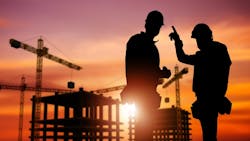Investment in Nonresidential Structures Declines 4.8% in Q1
WASHINGTON, DC — The U.S. economy expanded at a 6.4% annualized rate during the first quarter of 2021; however, investment in nonresidential structures declined at a 4.8% rate for the quarter, according to analysis conducted by Associated Builders and Contractors of data released today by the Bureau of Economic Analysis.
Many factors were at work in the overall expansion, including sizeable injections of stimulus in recent months and ongoing vaccinations. Personal consumption expenditures, fixed investment and federal, state and local government spending all supported growth.
“ABC economists have suggested for months that commercial real estate and construction would be among the last segments of the economy to recover,” said ABC Chief Economist Anirban Basu. “Today’s gross domestic product report makes it clear that while the broader economy continues to recover quickly, commercial real estate and construction dynamics are not nearly as positive.
“The U.S. economy expanded rapidly during the first quarter of 2021, but investment in nonresidential structures actually subtracted from growth,” said Basu. “The COVID-19 pandemic leaves in its wake low hotel occupancy rates, vacated offices and large blocks of abandoned retail space. Investment in nonresidential structures has now declined for six consecutive quarters, which means that the decline in this form of investment commenced prior to the COVID-19 pandemic.
“The expectation for rapid economic growth into 2022 remains firmly in place,” said Basu. “While many fret about input shortages, rising inflationary pressures, prospective tax increases and skyrocketing national debt, for now the sheer volume of federal spending will countervail all headwinds. Employment growth will be significant for months to come, which will help support commercial real estate fundamentals and eventually produce a rebound in commercial construction. Recent upticks in contractor confidence, according to ABC’s Construction Confidence Index, support this notion.
“However, there may come a time over the new few years when America starts to see faltering stimulus, massive federal debt service, more inflation, higher interest rates and loftier tax rates,” said Basu. “That set of circumstances would not support vigorous nonresidential construction spending in America.”
Visit abc.org/economics for the Construction Backlog Indicator and Construction Confidence Index, plus analysis of spending, employment, GDP and the Producer Price Index.
